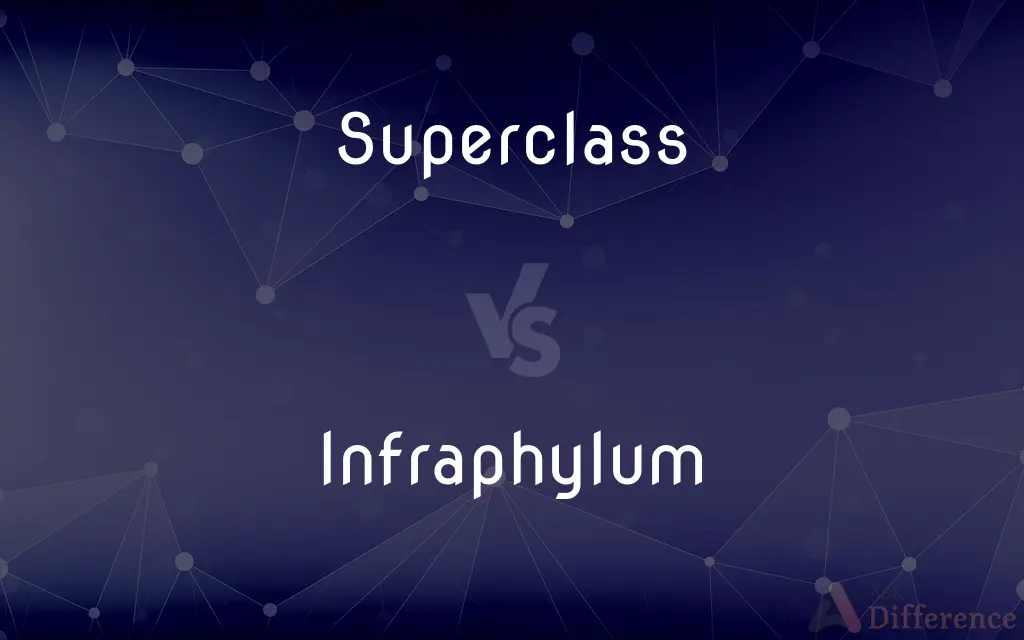Superclass vs. Infraphylum — What's the Difference?
By Tayyaba Rehman & Fiza Rafique — Updated on April 5, 2024
Superclass is a high-level taxonomic rank above class, grouping similar classes, while Infraphylum is a rank below phylum, dividing it into more specific groups.

Difference Between Superclass and Infraphylum
Table of Contents
ADVERTISEMENT
Key Differences
Superclass is a taxonomic rank used in the classification of organisms, sitting above the rank of class, grouping organisms that share a set of broad characteristics. It provides a way to understand the evolutionary relationships between different classes by grouping them under a broader category that shares fundamental traits. On the other hand, Infraphylum is a rank below the phylum and above the class, used to further divide organisms within a phylum into more specific groups. This rank allows scientists to categorize organisms into more defined groups that share more specific characteristics than those defined at the phylum level, thus refining our understanding of their evolutionary relationships.
Both superclass and infraphylum serve as hierarchical levels within the biological classification system, which helps in organizing the vast diversity of life. However, the key difference lies in their positions within this hierarchy. The superclass ranks above class and groups together classes that exhibit fundamental similarities. Whereas, infraphylum lies below the level of phylum and serves to further subdivide organisms within a phylum, offering a more granulated classification than the superclass.
In the context of taxonomy, the use of superclass and infraphylum allows for a more detailed and organized classification system. Superclass helps in understanding the broad evolutionary relationships between organisms by grouping similar classes, highlighting major evolutionary branches. In contrast, infraphylum provides a finer resolution within these branches, identifying more specific lineages and evolutionary paths within a phylum, thus enhancing our understanding of the diversity and complexity of life.
Another aspect where superclass and infraphylum differ is in their applicability across different kingdoms of life. Superclass is a rank that is used across various kingdoms, such as animals, plants, and fungi, to denote major evolutionary divisions. Infraphylum, on the other hand, is primarily used within the animal kingdom to further detail the subdivisions within a phylum, reflecting the unique evolutionary pathways and characteristics of animal lineages.
The choice between using superclass or infraphylum in classifying an organism depends on the level of specificity and the context of the classification needed. Superclass is chosen when there's a need to emphasize broad, fundamental evolutionary relationships, while infraphylum is used when the focus is on detailing the specific evolutionary trajectories within a phylum, demonstrating the flexibility and depth of the taxonomic classification system.
ADVERTISEMENT
Comparison Chart
Taxonomic Rank
Above class, groups similar classes
Below phylum, divides it into more specific groups
Hierarchical Level
Higher, indicates broader evolutionary relationships
Lower, indicates more specific evolutionary traits
Usage
Across various kingdoms (e.g., animals, plants)
Primarily in the animal kingdom
Purpose
Highlights major evolutionary branches
Details subdivisions within a phylum
Focus
Broad characteristics and evolutionary relationships
More specific characteristics and evolutionary paths
Compare with Definitions
Superclass
A taxonomic rank above class that groups together classes with similar fundamental traits.
In the classification of animals, Mammalia is a class grouped under the superclass Tetrapoda.
Infraphylum
A rank below phylum used to further divide organisms into more specific groups.
Vertebrata is an infraphylum under the phylum Chordata, including all vertebrates.
Superclass
Helps in understanding broad evolutionary relationships.
The presence of a backbone is a significant trait that differentiates the superclass Gnathostomata.
Infraphylum
Lies below the level of phylum, offering a more granular classification.
Infraphylum Tetrapoda divides vertebrates based on limb presence.
Superclass
Offers a flexible approach in categorizing organisms with fundamental similarities.
Superclass Sarcopterygii includes lobe-finned fishes and the tetrapods, underlining their evolutionary link.
Infraphylum
Primarily used within the animal kingdom for detailed classification.
The infraphylum Gnathostomata includes animals with jaws.
Superclass
Utilized across various kingdoms to denote broad evolutionary divisions.
The superclass Gymnospermae includes all classes of seed-producing plants that do not form flowers.
Infraphylum
Enables detailed classification within broad phylum categories.
Infraphylum Placodermi was used to classify extinct armored fishes, detailing their unique features within Chordata.
Superclass
Sits above class in the taxonomic hierarchy, indicating a higher level of abstraction in grouping organisms.
Superclass Agnatha groups jawless fishes, highlighting their primary evolutionary trait.
Infraphylum
Identifies specific evolutionary lineages within a phylum.
The infraphylum Hexapoda includes insects and their close relatives, reflecting their unique evolutionary path.
Superclass
A taxonomic category of related organisms ranking below a phylum or its subdivisions and above a class.
Infraphylum
(taxonomy) A taxon below subphylum and above superclass.
Superclass
A high-level class that passes attributes and methods down the hierarchy to subclasses.
Superclass
(taxonomy) A taxon ranking below a phylum and above a class.
Superclass
To create a superclass of.
Superclass
(biology) a taxonomic class below a phylum and above a class
Common Curiosities
How does superclass aid in understanding evolutionary relationships?
It highlights broad evolutionary branches by grouping classes with fundamental similarities.
Can a species belong to both a superclass and an infraphylum?
Yes, depending on its classification, a species can be part of both, reflecting its broad and specific evolutionary traits.
Is infraphylum used outside the animal kingdom?
Infraphylum is primarily used within the animal kingdom, although taxonomic systems can vary.
Can the rank of superclass be applied to plants?
Yes, superclass is a rank used across various kingdoms, including plants, to denote major evolutionary divisions.
What is a superclass?
A taxonomic rank that groups together classes based on fundamental similarities.
What distinguishes superclass from infraphylum?
Superclass is a higher taxonomic rank grouping similar classes, whereas infraphylum is a lower rank dividing a phylum into more specific groups.
What role does infraphylum play in taxonomy?
It provides a finer resolution within a phylum, detailing more specific evolutionary paths.
Do all organisms fit neatly into the existing taxonomic ranks?
While the system aims to be comprehensive, new discoveries and genetic data continuously refine and challenge existing classifications.
How does the use of superclass and infraphylum enhance classification?
They allow for both broad and specific grouping of organisms, enhancing understanding of evolutionary relationships.
How does taxonomic hierarchy affect biological research?
It organizes the vast diversity of life, aiding in the study of evolutionary relationships and biodiversity.
Are superclass and infraphylum universally accepted ranks?
While widely used, taxonomic ranks can vary based on different classification systems.
What is an example of an organism in a specific infraphylum?
Sharks and rays are examples within the infraphylum Gnathostomata, characterized by the presence of jaws.
Share Your Discovery

Previous Comparison
Provision vs. Principle
Next Comparison
Half vs. PartialAuthor Spotlight
Written by
Tayyaba RehmanTayyaba Rehman is a distinguished writer, currently serving as a primary contributor to askdifference.com. As a researcher in semantics and etymology, Tayyaba's passion for the complexity of languages and their distinctions has found a perfect home on the platform. Tayyaba delves into the intricacies of language, distinguishing between commonly confused words and phrases, thereby providing clarity for readers worldwide.
Co-written by
Fiza RafiqueFiza Rafique is a skilled content writer at AskDifference.com, where she meticulously refines and enhances written pieces. Drawing from her vast editorial expertise, Fiza ensures clarity, accuracy, and precision in every article. Passionate about language, she continually seeks to elevate the quality of content for readers worldwide.













































